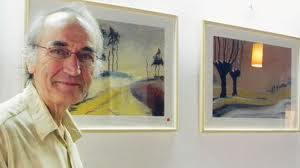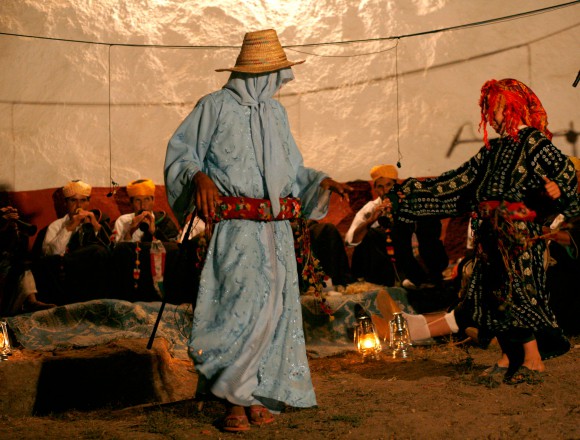Increased security level to stop jihadists fleeing northern Mali.
There is concern in Morocco over the possibility of hard-line fighters entering Morocco after fleeing Mali, especially after the appeal made in a recent statement from the
Al-Qaeda in the Lands of the Islamic Maghreb (AQIM). It was the first statement to be issued by AQIM since the beginning of the African and French military intervention in Mali.
In recent weeks, Moroccan security agencies investigated a group of individuals affiliated with the Salafi jihadist movement. Authorities released them without charge after taking their statements. The investigation was a precautionary step.
Earlier this year, Moroccan authorities arrested several networks that were recruiting and sending fighters to Mali and Syria.
Recently, Salafi jihadists have been circulating video footages showing Moroccan recruits carrying weapons and fighting in Syria and Mali. The jihadists use the footage in order to promote and publicize their activities in Mali and Syria.
Moroccan security analysts believe that since Morocco has no direct joint border with Mali the threat posed by jihadists is small when compared with that posed to Algeria and Mauritania.
Moreover, the Al-Qaeda threat in Morocco is not as severe as in other North Africa countries. Abdallah Elrami, a Moroccan researcher at the Royal Institute for Strategic Studies, specializing in Islamic groups, believes that Al-Qaeda failed to establish a foothold in Morocco because of the heavy blows it received at the hands of Moroccan security agencies.
According to Elrami, "The groups that left Morocco for Mali were small in number, unlike the people who we saw leave Mauritania and Algeria. It will be difficult for them to return home because the security authorities are monitoring them. On the other hand, there is no favorable environment or strong and organized networks that would harbor them in Morocco as is the case in Algeria where the head of the AQIM command is based."
Elrami added that senior AQIM officials, led by the organization chief Abdelmalik Droukdel himself, said that they failed to establish channels of communication, coordination, and logistical support with Salafi jihadists in Morocco because of the security agencies continuous monitoring, which has prevented the setting up of an Al-Qaeda branch in Morocco.
Rising costs cause pilgrimage problems.
Travel agencies specializing in spiritual tourism, including Umrah (pilgrimage to Mecca), have been having a tough time lately. Tour operators say that the increasingly competitive market has become something of a nightmare with some pilgrims becoming the victim of scams.
Majdi Khalil, President of the Federation of Travel Agencies in Morocco (FNAVM) says "The demand is there, but travel agencies in Morocco do not have a clear picture of this vital niche market. Annually an average of more than 50,000 Moroccans average perform Umrah pilgrimages. Yet we have only 30,000 identified in our Haj operation".
 |
| Clock Hotel Mecca |
In addition, the hotel sector in Mecca has been undergoing changes. Hundreds of hotels have been demolished as part of a large redevelopment project underway to accommodate 10 million pilgrims by 2020 against 3 or 4 million today. Over the past decade, the face of Mecca has changed considerably. Modern buildings surrounding the Grand Mosque, such as the "Mecca Clock" a prestigious hotel of 120 floors inspired by Big Ben in London and other projects designed by the Saudi authorities to provide pilgrims prayer spaces have resulted in a price increase.
"The hotel industry has become more expensive. During the period of Ramadan 4 and 5 star hotels charge exorbitant prices,"says Majdi.
And it is not just that prices that will discourage Moroccans.
"Booking hotel rooms has become increasingly difficult. You must have a good network in Saudi Arabia on site in order to save the day. And people must be aware that prices have risen more than 35%," says Mustapha Kaddouri a tour operator in Oujda where pilgrims go for direct flights to Mecca.
The direct flight demands of tourists are only available through Royal Air Morocco (RAM) and Saudi Arabian Airlines, while airlines like Turkish Airlines, Lufthansa, Qatar Airways all make stops in Istanbul, Cairo or Dubai, which are not always the preference of pilgrims.
Tour operators warn that with the present problems pilgrims need to be careful as some have become victims of scams.
Airline in charity drive.
Air Arabia Morocco has linked up with SOS Children's Villages. The airline has formalized its partnership with SOS Children's Villages and launched a project called "Cloud Charity Morocco".
The aim is to raise funds for the association and create shelters, provide care and offer a better education in Africa. The low cost airline will invite passengers to donate through a system of envelopes handed out on their flights.
By the end of February Moroccans had raised over 3.3 million dirhams, or about 300,000 euros.
SOS Children's Villages (German: SOS-Kinderdorf) is an independent, non-governmental international development organisation which has been working to meet the needs and protect the interests and rights of children since 1949.
It was founded by Austrian Hermann Gmeiner. According to the Financial Times, the 2004 turnover of SOS Children's Villages altogether was US$ 807 million, and it was ranked 33 out of a 100 global NGOs for "global accountability". Its international umbrella organisation,
SOS-Kinderdorf International, was founded in 1960, after national associations had been established in France, Germany and Italy in addition to the original Austrian association. Over a hundred national associations across the world have since been established.
OPINION - Beware taking some tripadvisor reviews at face value.
A recent posting on
Tripadvisor has been pointed out to
The View from Fez as an example of just how damaging one person's jaundiced point of view can be. While in no way wanting to stop people expressing their point of view, some things are simply just wrong.
 |
| Fez - "a glorified slum" ? |
In the recent case a gentleman from Melbourne Australia launched into an attack on Fez that was unwarranted and so far from the facts that one wonders where he actually visited.
"A slum is a slum by any other names (sic)"
His review of Fez started with ...
A slum is still a slum by any other names. This place in Fes may be a world heritage site with few changes since its beginning, but it is still a dirty dangerous place. Colourful tourist brochures or travel documentary may paint it exotic and fascinating but when there in person the reality hits you when accosted by the smell and rubbish everywhere together with the brashness of the people waiting to empty your pockets.
Yes, Fez, like anywhere else does have a smell. Sometimes it is the earthy smell of donkey droppings, at others the smell of spicy food being cooked, of cedar being used by woodworkers and at the time of writing, the sweet smell of orange blossom in bloom.
"A dirty dangerous place"? - Rubbish collection in Fez is a daily occurrence, unlike Melbourne where it is only once a week. And as for danger, figures released by the Victorian Police show Melbourne to be a far more dangerous place with murder, rape and assault figures numbering in the hundreds. Fez by comparison is a haven of tranquility. Even nationwide the figures are impressive. The average of 59 people murdered by firearms per year in Australia compares to 1 in Morocco.
 |
| A tourist checking out a donkey on a nice clean street in Fez! |
It is a large labyrinth of ancient buildings, characterized by endless winding narrow slippery laneways, strewn with wet and dry rubbish, even animal dung on uneven cobbled stones. No motorized vehicles can get through nor allowed except perhaps motorcycles. The usual mode of transport would be hand drawn carts or donkeys.
The description
"large labyrinth of ancient buildings, characterized by endless winding narrow slippery laneways" is part of the charm of Fez. That this is a characteristic of the Medina is what has made it such a Mecca for tourists. The animal transport in the medina is a constant delight and it would be hard to find a single tourist who has not wanted to photograph the animals. An increasing number of tourists also visit the
American Fonduk, the charity veterinary hospital that cares for the working animals of the Medina.
 |
| Artisans in Fez |
Small shops and tourist outlets abound to sell local handicrafts, carpets, leather goods, clothing, brass wares, jewellery, food and drinks.
The so-called tourist outlets are patronised by local Moroccans who far out number tourists in purchasing. It is an orientalist view that local handcrafts are simply for tourists. Around 90% of sales in the Medina are to Moroccans.
Once you start the journey in there’s no turning back. You need a good old pair of shoes and be prepared to get them dirty. There’ no place for you to sit and rest along the way and of course you’ll be in trouble should you need the toilets.
This is just wrong. Toilets and washrooms are available. One only has to ask. There are lots of places to sit, in fact, sitting over a glass of mint tea and watching the passing throng is a favourite pastime.
 |
| Fez - plenty of places to sit and watch the passing parade of people |
We were warned to be alert for pick pockets. Somehow you feel unseen eyes watching your every move and at one stage we got pebbles thrown in our direction. Frankly, I would avoid this place but if you insist on visiting a medina in Morocco, the one in Marrakesh is better, cleaner and less intimidating.
We read this paragraph and wondered why the gentleman did not simply stay at home. The paranoia about people watching is laughable and as the Moroccans will tell you, the tourists are watching us far more closely! And you are more likely to be robbed in St Kilda than in Fez. As many Australian women travelling alone in Morocco have noted, they feel safer at night in Fez than they do in most Australian cities.
We are not going to get into a Marrakech versus Fez discussion - it is much like the rivalry between Sydney and Melbourne - but Marrakech while not being the cultural and spiritual heart of the country, is a delight for shopping although the Medina now has few working artisans - a big difference from Fez... and did we mention the Marrakech motorcycle menace...?
Of course he is welcome to his opinion, but it was interesting to note that out of the 700 plus reviews of Fez, only 16 people appear to agree with the gentleman from Melbourne. We hope he returns and lets us offer him an alternate view of Fez













































